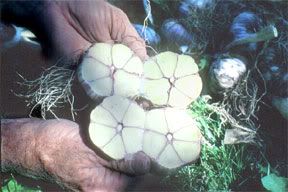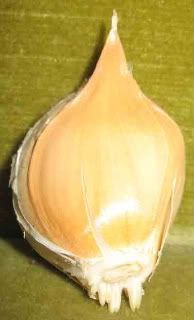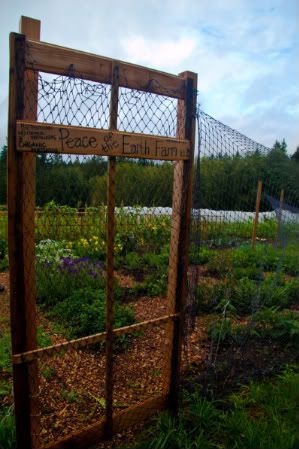Garlic 101
There are 2 main types of garlic, hard neck and soft neck. Soft neck varieties are the kind most commonly found in grocery stores because their shelf life is significantly longer than hard neck varieties. In fact, if dried and stored properly, soft necks can last all winter and spring long. Hard neck varieties tend to have a stronger flavor than soft necks but are best fresh or consumed within a few months of harvest. Hard necks generally produce one row of large cloves around a center stem (fig 1). This stem will produce an edible flower called a scape in the late spring (fig 2). This scape should be pulled out when it starts to curve all the way around. Pulling the scape prevents the garlic from going to seed. If this scape is not pulled out, then the clove will not develop into a full bulb of garlic and it will put all its energy into making it's flower and subsequent seeds. These scapes are a real treat and can be eaten raw like chives, cooked in a stir fry, or my personal favorite, all grilled up on the barbecue. They have a that wonderful garlic flavor and are a bit spicy! Soft neck varieties typically have several rows of cloves (fig 3). The cloves on the outside are about medium sized and get smaller and smaller towards the center. Soft neck varieties (in all but a few cases) do not have a scape and therefore have a less rigid neck. This makes them the ideal varieties for one of my favorite late summer activities: garlic braiding. Garlic braids make excellent holiday gifts because they are both edible and beautiful. You'll be able to purchase garlic braids next summer and fall here at the farm. I like to weave in dried flowers and even cayenne peppers for some extra color and flavor.
Fig 1: the Inside of Hardneck Garlic:

Fig. 2: Garlic Scape

Fig 3: The Inside of Soft Neck Garlic

Garlic Planting:
In the fall, usually late October or even November is the right time to plant garlic in the Pacific Northwest. If you plant a clove of garlic in the fall, by summer you will have a whole bulb of garlic. Plant cloves about 4 to 6 inches apart about 1 to 4 inches deep. Cover with a mulch such as straw to help insulate and protect garlic as it rests during the winter. Planting in a fall is important because garlic needs the cold winter months for proper growth. However in very cold climates make sure you plant 4 to 6 weeks before the ground has a hard freeze to help establish a root system. When you buy seed garlic it usually comes in a bulb. Crack open bulbs and separate cloves very carefully. Try not to bruise or scrape the tissue of the clove because this will increase the chance of the clove getting infected with a fungus or other unwanted disease. You do not need to fully peel the garlic clove, just separate them from one another. Bulbs should be broken only a day or two before planting. There is a direct correlation between the size of the clove and the size of the bulb. Small cloves make smaller bulbs, bigger cloves makes bigger bulbs. Therefore most gardeners and farmers only plant the largest cloves and save the rest for cooking or give them to kids or neighbors to plant. Also pay special attention to the orientation of the clove. Make sure you put the basil end down, this is where the roots will grow from (fig 4). One last note, garlic is very susceptible to disease and should never be planted in the same place two years in a row. Rotate the place where you grow garlic and pay special attention to the bulbs you buy for seed. Be wary of planting grocery store garlic or garlic from neighbors or even local farmers. Once you get white rot, which is a common garlic fungus, it's in the soil pretty much for good. Also remember that, good fresh healthy garlic is always very hard. If your seed garlic is soft in any spot don't plant it. In fact, it's probably a good idea to dispose of the clove and even the whole bulb and then wash your hands before touching the rest of the garlic.
Fig 4: This is the orientation that the clove should be in for planting

Spring Maintenance:
Garlic should be sown in well drained moist soil and mulched with straw or another mulch to help retain soil moister. Water if necessary in May and June however cut off water in June to help aid in the drying out process. Fertilize the garlic in February and then again in April but not again. Fertilizing after this point will cause plant to put out more green above ground growth and we want the plant to focus on its bulb. I recommend using an organic liquid fertilizer like fish emulsion or worm casting compost tea with some kelp meal. Sorry but I can never recommend chemical fertilizers for anything because I believe they are not healthy for humans, plants, animals or the earth! Pull back the straw mulch a couple times in the spring to weed and then put back mulch. Remember to pull those scapes from the hard neck varieties when they are all curled around. Harvest garlic when there are 2 to 3 mature scales surrounding the bulb, probably June or July. The above ground leafy growth can also be eaten like a you would a leek. To dry, bunch up 6 to 10 bulbs by their leaves and hang in cool dry place away from direct sun light. Once the garlic is dried (in a bout 2 to 4 weeks). Store at 50 degrees with humidity at 50% to 65%. This will help keep the garlic fresh and keep it form sprouting.
Finding Seed Garlic
Right now you can get some lovely soft neck garlic from my favorite seed company "Uprising Seeds". This is a local Washington company that grows and sells organic seeds. They are located in Bellingham, Washington and grow almost all of their own seed, the remaining bit of seed they distribute was grown by other Washington farmers. They have an emphasis on heirloom varieties are 100% organic and they just plain rock in terms of service and their love of the earth, this is a great company to support. Find them at http://uprisingorganics.com/
Some other good sources for seed garlic are High Mowing Seeds, Peaceful Valley Farm Supply, Territorial Seeds, and Fillery.
Good luck... now... go plant that Garlic!!

No comments:
Post a Comment